Lowrance X515CDF, X510C User Manual
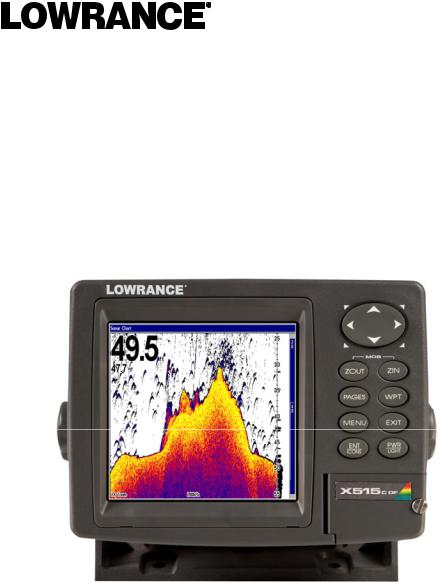
Pub. 988-0151-451
www.lowrance.com
X510C & X515C DF
Fish-finding and Depth Sounding Sonars
Operation Instructions
Copyright © 2006 Lowrance Electronics, Inc.
All rights reserved.
No part of this manual may be copied, reproduced, republished, transmitted or distributed for any purpose, without prior written consent of Lowrance Electronics. Any unauthorized commercial distribution of this manual is strictly prohibited.
Lowrance® is a registered trademark of Lowrance Electronics, Inc.
Lowrance Electronics may find it necessary to change or end our policies, regulations, and special offers at any time. We reserve the right to do so without notice. All features and specifications subject to change without notice. All screens in this manual are simulated. On the cover: X515cDF shown.
For free owner's manuals and other information, visit our web site:
www.lowrance.com
Lowrance Electronics Inc.
12000 E. Skelly Dr.
Tulsa, OK USA 74128-2486
Printed in USA.
Table of Contents |
|
Section 1: Read Me First! ......................................................... |
1 |
Capabilities and Specifications: X-510c & X-515cDF ................. |
2 |
How Sonar Works.......................................................................... |
3 |
How to use this manual: typographical conventions .................. |
4 |
Section 2: Installation & Accessories.................................... |
7 |
Preparations .................................................................................. |
7 |
Transducer Installation ................................................................ |
7 |
Single-frequency transom installations............................... |
8 |
Dual-frequency transom installations ................................. |
8 |
Single-frequency trolling motor installations ..................... |
8 |
Shoot-through hull installations .......................................... |
8 |
Selecting a Transducer Location.............................................. |
8 |
How low should you go? ............................................................ |
9 |
Shoot-thru-hull vs. Transom Mounting................................. |
10 |
Transom Transducer Assembly And Mounting .................... |
11 |
Trolling Motor Bracket Installation (single-frequency only) 17 |
|
Transducer Orientation and Fish Arches.............................. |
17 |
Shoot-Thru-Hull Preparation................................................. |
18 |
Hulls With Floatation Materials........................................ |
18 |
Testing Determines Best Location......................................... |
19 |
Shoot-thru-hull Installation ................................................... |
21 |
Speed/Temperature Sensors ................................................. |
22 |
Optional Speed Sensor Installation ....................................... |
22 |
Power Connections...................................................................... |
24 |
Powering Your Display Unit ...................................................... |
25 |
Power Diagram A ........................................................................ |
27 |
Power Diagram B ........................................................................ |
28 |
Powering a NMEA 2000 Network Bus ...................................... |
28 |
NMEA 0183 Cable Connections ................................................. |
29 |
Mounting the Unit: Bracket, In-Dash or Portable.................... |
29 |
Other Accessories ........................................................................ |
33 |
Cleaning Towel........................................................................ |
33 |
Face Cover ................................................................................... |
33 |
Section 3: Basic Sonar Operation ........................................ |
35 |
Keyboard...................................................................................... |
35 |
Power/lights on and off ............................................................... |
36 |
Menus........................................................................................... |
36 |
Main Menu............................................................................... |
36 |
Sonar Menu.............................................................................. |
38 |
Pages ............................................................................................ |
39 |
Basic Sonar Quick Reference ..................................................... |
43 |
Sonar Operations ........................................................................ |
44 |
i |
|
Fish Symbols vs. Full Sonar Chart ........................................ |
46 |
Other Free Training Aids ....................................................... |
47 |
Section 4: Sonar Options & Other Features...................... |
49 |
ASP™ (Advanced Signal Processing) ..................................... |
49 |
Alarms.......................................................................................... |
50 |
Depth Alarms .......................................................................... |
50 |
Zone Alarm .............................................................................. |
51 |
Fish Alarm ............................................................................... |
52 |
Brightness.................................................................................... |
53 |
Calibrate Speed ........................................................................... |
53 |
Chart Speed ................................................................................. |
54 |
Colorline....................................................................................... |
55 |
Contrast ....................................................................................... |
56 |
Depth Cursor ............................................................................... |
56 |
Depth Range - Automatic ........................................................... |
56 |
Depth Range - Manual................................................................ |
57 |
Depth Range - Upper and Lower Limits ................................... |
57 |
FasTrack™................................................................................... |
59 |
Fish I.D.™ (Fish Symbols & Depths) ......................................... |
60 |
FishTrack™.................................................................................. |
61 |
Frequency (Change Transducer Frequency) (X-515cDF only). 62 |
|
HyperScroll™............................................................................... |
63 |
Noise Rejection ............................................................................ |
63 |
Overlay Data ............................................................................... |
63 |
Ping Speed & HyperScroll™....................................................... |
65 |
Pop-up Help ................................................................................. |
67 |
Reset Options............................................................................... |
67 |
Reset Water Distance.................................................................. |
68 |
Screen Contrast and Brightness ................................................ |
68 |
Sensitivity & Auto Sensitivity.................................................... |
69 |
Automatic Sensitivity ............................................................. |
70 |
Set Keel Offset............................................................................. |
71 |
Set Language............................................................................... |
72 |
Software Version Information.................................................... |
73 |
Sonar Chart Mode ....................................................................... |
73 |
Sonar Chart Display Options ..................................................... |
74 |
Full Sonar Chart ..................................................................... |
74 |
Split Zoom Sonar Chart .......................................................... |
75 |
Split Frequency Sonar Chart (X-515cDF only) ..................... |
75 |
Digital Data/Chart .................................................................. |
76 |
Customizing the Digital Data/Chart Screen ..................... |
77 |
Flasher ..................................................................................... |
78 |
Sonar with Custom Gauges ........................................................ |
79 |
ii |
|
Radar............................................................................................ |
81 |
Sonar Simulator .......................................................................... |
81 |
Stop Chart.................................................................................... |
82 |
Surface Clarity ............................................................................ |
82 |
Transducer Type (X-515cDF only) ............................................. |
83 |
Transparency............................................................................... |
84 |
Units of Measure ......................................................................... |
85 |
Upper and Lower Limits............................................................. |
86 |
Zoom & Zoom Bar........................................................................ |
86 |
Zoom Pan ..................................................................................... |
87 |
Section 5: NMEA 2000 Menu.................................................. |
89 |
NMEA 2000 Menu....................................................................... |
89 |
Bus Setup..................................................................................... |
89 |
Engine & Tank Configuration.................................................... |
90 |
Tank Select .......................................................................... |
91 |
Tank Size ............................................................................. |
91 |
Set Configuration button .................................................... |
91 |
Device Configuration Menu.................................................... |
92 |
Device Information and Device Data..................................... |
92 |
Fuel Management Menu............................................................. |
93 |
Tank Location...................................................................... |
93 |
Fuel Added........................................................................... |
93 |
Add Fuel............................................................................... |
94 |
Fill Tank............................................................................... |
94 |
Adding Fuel to Tank ............................................................... |
94 |
Engine Operations................................................................... |
94 |
Engine Select ....................................................................... |
94 |
NMEA 2000 Alarms .................................................................... |
95 |
To set NMEA 2000 Alarm:.................................................. |
96 |
Waypoint Sharing ....................................................................... |
96 |
Backlight Synchronization ......................................................... |
96 |
Configuring EP Sensors.............................................................. |
97 |
EP-35 Temperature Configuration ........................................ |
97 |
Advanced Options menu ......................................................... |
97 |
Instance................................................................................ |
98 |
Restore Defaults .................................................................. |
98 |
To restore default settings.................................................. |
98 |
EP-10 Fuel Flow Configuration.............................................. |
98 |
Advanced Options menu ......................................................... |
99 |
Instance................................................................................ |
99 |
Restore Defaults .................................................................. |
99 |
EP-15 Fluid Level Configuration ......................................... |
100 |
Advanced Options menu ....................................................... |
102 |
iii |
|
Instance.............................................................................. |
102 |
Restore Defaults ................................................................ |
102 |
To restore default settings:............................................... |
102 |
Suzuki Engine Interface Configuration............................... |
103 |
Advanced Options menu ....................................................... |
104 |
Instance.............................................................................. |
104 |
Restore Defaults ................................................................ |
104 |
Calibrating EP Sensors............................................................. |
105 |
EP-10 Fuel Flow Calibration................................................ |
105 |
EP-15 Fluid Level Calibration ............................................. |
106 |
2-Point Calibration............................................................ |
106 |
3-Point Calibration................................................................ |
107 |
5-Point Calibration............................................................ |
108 |
Fuel Flow Calibration in a Suzuki Engine Interface.......... |
109 |
Engine Trim Calibration....................................................... |
110 |
Reset Trim Calibration ......................................................... |
111 |
Bennett Trim Tabs Calibration............................................ |
111 |
Section 6: Sonar Troubleshooting ..................................... |
113 |
NOTICE!
The storage and operation temperature range for your unit is from -20 degrees to +167 degrees Fahrenheit (-28 degrees to +75 degrees Celsius). Extended storage or operation in temperatures higher or lower than specified will damage the liquid crystal display in your unit. This type of damage is not covered by the warranty. For more information, contact the factory's Customer Service Department; phone numbers are listed on the last page of the manual.
iv
Section 1: Read Me First!
How this manual can get you out on the water, fast!
Welcome to the exciting world of digital sonar! We know you're anxious to begin finding fish, but we have a favor to ask. Before you grab your unit and begin installing it, please give us a moment or two to explain how our manual can help you get the best performance from your compact, wide-screen, fish finder.
First, we want to thank you for buying a Lowrance sonar. Whether you're a first time user or a professional fisherman, you'll discover that your unit is easy to use, yet capable of handling demanding sonar tasks. You won't find another sonar unit with this much power and this many features for this price!
Our goal for this book is to get you on the water fast, with a minimum of fuss. Like you, we'd rather spend more time boating or fishing and less time reading the manual!
So, we designed our book so that you don't have to read the whole thing from front to back for the information you want. At the start (or end) of each segment, we'll tell you what content is coming up next. If it's a concept you're already familiar with, we'll show you how and where to skip ahead for the next important topic. We've also made it easy to look up any tips you may need from time to time. Here's how:
The manual is organized into 6 sections. This first section is an introduction to the sonar unit. It tells you the basics you need to know before you can make the unit look below the surface to find some fish.
Section 2 will help you install your unit and the transducer. We'll also tell you about some of the available accessories.
Section 3 covers Basic Sonar Operation. It will show you how easy it is to run your sonar, right out of the box. This section features a one-page Sonar Quick Reference. (If you've already jumped ahead and figured out how to install the unit yourself, and you just can't wait any longer, turn to the Quick Reference on page 43 and head for the water with your sonar unit!)
After you've gained some experience with your sonar, you'll want to check out Section 4, which discusses more advanced Sonar Options and Other Features.
When you come to a sonar menu command on the unit's screen, you can look it up in the manual by skimming over the table of contents or index, just flipping through Section 3 or scanning through the sonar options in Section 4.
1
If you're having difficulty with your sonar, you can find an answer to the most common problems in Section 5, Sonar Troubleshooting.
Finally, in Section 6, we offer Supplemental Material, including a list of warranty and customer service information.
Now, if you're into the fine details, glance over the next segment on specifications to see just how much sonar power your unit contains. It's important to us (and our power users), but, if you don't care how many watts of power the unit has, skip ahead to important information on how sonar works, on page 3.
Capabilities and Specifications: X-510c & X-515cDF General
Display: ............................. |
5.0" (12.7 cm) diagonal high color contrast |
|
Film SuperTwist; programmable to viewing |
|
preference. |
Resolution: ...................... |
480 pixel x 480 pixel resolution ; 230,400 to- |
|
tal pixels. |
Backlighting: .................. |
X-510c, X-515cDF |
|
White LED backlit screen and keypad. |
Input power: ................... |
10 to 15 volts DC. |
Case size: ......................... |
5.4" H x 6.9" W x 3.4" D (13.8 x 17.6 x 8.6 |
|
cm); sealed and waterproof; suitable for |
|
saltwater use. |
Back-up memory:........... |
Built-in memory stores sonar records for |
|
decades. |
Languages: ...................... |
10; menu languages selectable by user. |
|
Sonar |
Frequency: ...................... |
50/200 kHz for X-515cDF; 200 kHz for X- |
|
510c. |
Transducers:................... |
A dual-frequency Skimmer® transducer with |
|
built-in temperature sensor is packed with |
|
the X-515cDF. It has 35°/12° cone angles. A |
|
single-frequency with built-in temperature |
|
sensor is packed with the X-510c. It has a |
|
20° cone angle. Transducers operate at |
|
speeds up to 70 mph (61 kts). |
2
Transmitter:.................... |
X-515cDF: |
|
4,000 watts peak-to-peak/500 watts RMS. |
|
X-510c: |
|
2,400 watts peak-to-peak/300 watts RMS. |
Sonar sounding |
X-515cCDF: 2,500 feet (762 meters). |
depth capability:............ |
|
|
X-510c: 800 feet (244 meters). |
|
Actual capability depends on transducer con- |
|
figuration and installation, bottom composi- |
|
tion and water conditions. All sonar units |
|
typically read deeper in fresh water than in |
|
salt water. |
Depth display: ................ |
Continuous display. |
Audible alarms:.............. |
Deep/shallow/fish/zone. |
Automatic ranging: ....... |
Yes, with instant screen updates. |
Auto bottom track: ........ |
Yes. |
Zoom bottom track:....... |
Yes. |
Split-screen zoom: ......... |
Yes. |
Surface water temp: ..... |
Yes. |
Speed/distance log: ....... |
Optional (requires optional speed sensor). |
NOTICE!
The storage temperature range for your unit is from -4 degrees to +167 degrees Fahrenheit (-20 degrees to +75 degrees Celsius). Extended storage in temperatures higher or lower than specified will damage the liquid crystal display in your unit. This type of damage is not covered by the warranty. For more information, contact the factory's Customer Service Department; phone numbers are listed on the last page.
How Sonar Works
Sonar has been around since the 1940s, so if you already know how it works, skip ahead to the next segment on the typographical conventions used in this manual. But, if you've never owned a sonar fish finder, this segment will tell you the under water basics.
Sonar is an abbreviation for SOund NAvigation and Ranging, a technology developed during World War II for tracking enemy submarines. (Lowrance developed the world's first transistorized sportfishing sonar in 1957.) A sonar consists of a transmitter, transducer, receiver and display. In simple terms, here's how it finds the bottom, or the fish:
3
The transmitter emits an electrical impulse, which the transducer converts into a sound wave and sends into the water. (The sound frequency can't be heard by humans or fish.) The sound wave strikes an object (fish, structure, bottom) and bounces back to the transducer, which converts the sound back into an electrical signal.
The receiver amplifies this return signal, or echo, and sends it to the display, where an image of the object appears on the scrolling sonar chart. The sonar's microprocessor calculates the time lapse between the transmitted signal and echo return to determine the distance to the object. The whole process repeats itself several times each second.
How to use this manual: typographical conventions
Many instructions are listed as numbered steps. The keypad and arrow "keystrokes" appear as boldface type. So, if you're in a real hurry (or just need a reminder), you can skim the instructions and pick out what menu command to use by finding the boldface command text. The following paragraphs explain how to interpret the text formatting for those commands and other instructions:
Arrow Keys
The arrow keys control a horizontal line depth cursor on the sonar screen. The arrow keys also help you move around the menus so you can execute different commands. They are represented by symbols like these, which denote the down arrow key, the up arrow, the left arrow and the right arrow: ↓ ↑ ← →.
Keyboard
The other keys perform a variety of functions. When the text refers to a key to press, the key is shown in bold, sans serif type. For example, the "Enter/Icons" key is shown as ENT and the "Menu" key is shown as MENU.
Menu Commands
A menu command or a menu option will appear in small capital letters, in a bold sans serif type like this: DEPTH CURSOR. These indicate that you are to select this command or option from a menu or take an action of some kind with the menu item. Text that you may need to enter or file names you need to select are show in italic type, such as data type.
Instructions = Menu Sequences
Most functions you perform with the sonar unit are described as a sequence of key strokes and selecting menu commands. We've written them in a condensed manner for quick and easy reading.
4
For example, instructions for turning on the Fish ID™ feature would look like this:
1.From the Sonar Page, press MENU|↓ to SONAR FEATURES|ENT.
2.Press → to FISH SYMBOLS|ENT|EXIT|EXIT.
Translated into complete English, step 1 above would mean: "Start on the Sonar Page. Press the Menu key then repeatedly press (or press and hold) the down arrow key to scroll down the menu and select (highlight) the Sonar Features menu command. Then press the Enter key."
Step 2 would mean: "Press the right arrow key to select (highlight) the Fish ID symbols command. Next, press the Enter key, then press the Exit key twice."
5
Notes
6
Section 2:
Installation & Accessories
Preparations
You can install the sonar system in some other order if you prefer, but we recommend this installation sequence:
Caution:
You should read over this entire installation section before drilling any holes in your vessel!
1.Determine the approximate location for the sonar unit, so you can plan how and where to route the cables for the transducer and power. This will help you make sure you have enough cable length for the desired configuration.
2.Determine the approximate location for the transducer and its cable route.
3.Determine the location of your battery or other power connection, along with the power cable route.
4.Install the transducer and route the transducer cable to the sonar unit.
5.Install the power cable and route it to the sonar unit.
6.Mount the sonar unit.
Transducer Installation
These instructions will help you install your Skimmer® transducer on a transom, on a trolling motor or inside a hull. These instructions cover both singleand dual-frequency Skimmer transducers. Please read all instructions before proceeding with any installation.
The smaller single-frequency Skimmers typically use a one-piece, stainless steel mounting bracket. The larger dual-frequency Skimmers typically use a two-piece, plastic mounting bracket. The trolling motor mount uses a one-piece plastic bracket with an adjustable strap.
These are all "kick-up" mounting brackets. They help prevent damage if the transducer strikes an object while the boat is moving. If the transducer does "kick-up," the bracket can easily be pushed back into place without tools.
Read these instructions carefully before attempting the installation. Determine which of the mounting positions is right for your boat. Remember, the transducer installation is the most critical part of a sonar installation.
7
NOTE:
The following installation types also call for these recommended tools and required supplies that you must provide (supplies listed here are not included):
Single-frequency transom installations
Tools include: two adjustable wrenches, drill, #29 (0.136") drill bit, flathead screwdriver. Supplies: high quality, marine grade aboveor belowwaterline sealant/adhesive compound.
Dual-frequency transom installations
Tools: two adjustable wrenches, drill, #20 (0.161") drill bit, flat-head screwdriver. Supplies: four, 1" long, #12 stainless steel slotted wood screws, high quality, marine grade aboveor below-waterline sealant/adhesive compound.
Single-frequency trolling motor installations
Tools: two adjustable wrenches, flat-head screwdriver. Supplies: plastic cable ties.
Shoot-through hull installations
Tools: these will vary depending on your hull's composition. Consult your boat dealer or manufacturer. Other tools are a wooden craft stick or similar tool for stirring and applying epoxy, and a paper plate or piece of cardboard to mix the epoxy on. Supplies: rubbing alcohol, 100 grit sandpaper, specially formulated epoxy adhesive available from LEI (see ordering information on the inside back cover). A sandwich hull also requires polyester resin.
Selecting a Transducer Location
1.The location must be in the water at all times, at all operating speeds.
2.The transducer must be placed in a location that has a smooth flow of water at all times. If the transducer is not placed in a smooth flow of water, interference caused by bubbles and turbulence will show on the sonar's display in the form of random lines or dots whenever the boat is moving.
NOTE:
Some aluminum boats with strakes or ribs on the outside of the hull create large amounts of turbulence at high speed. These boats typically have large outboard motors capable of propelling the boat at speeds faster than 35 mph. Typically, a good transom location on aluminum boats is between the ribs closest to the engine.
3.The transducer should be installed with its face pointing straight down, if possible. For shoot-thru applications: Many popular fishing
8
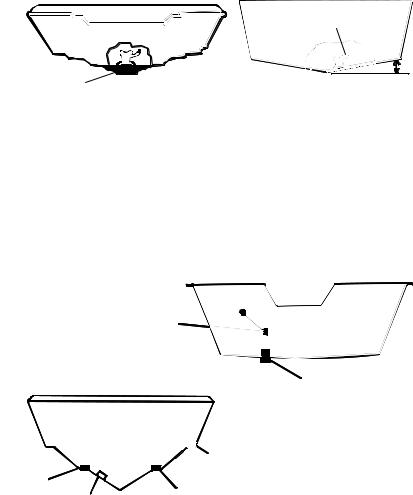
boat hulls have a flat keel pad that offers a good mounting surface. On vee hulls, try to place the transducer where the deadrise is 10° or less.
Deadrise less than 10°
Pad
 Strakes
Strakes
Left, vee pad hull; right, vee hull. A pod style transducer is shown here, but the principle is the same for Skimmers inside a hull.
4.If the transducer is mounted on the transom, make sure it doesn't interfere with the trailer or hauling of the boat. Also, don't mount it closer than approximately one foot from the engine's lower unit. This will prevent cavitation (bubble) interference with propeller operation.
5.If possible, route the transducer cable away from other wiring on the boat. Electrical noise from engine wiring, bilge pumps and aerators can be displayed on the sonar's screen. Use caution when routing the transducer cable around these wires.
CAUTION: Clamp the transducer cable to transom near the transducer. This will help prevent the transducer from entering the boat if it is knocked off at high speed.
Good location
|
Poor location |
Good |
|
location |
Good location |
Poor angle |
Good and poor transducer locations.
How low should you go?
For most situations, you should install your Skimmer transducer so that its centerline is level with the bottom of the boat hull. This will usually give you the best combination of smooth water flow and protection from bangs and bumps.
9
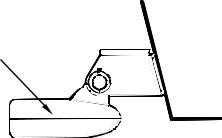
Transom
Transducer centerline
Hull bottom
Align transducer centerline with hull bottom.
However, there are times when you may need to adjust the transducer slightly higher or lower. (The slots in the mounting brackets allow you to loosen the screws and slide the transducer up or down.) If you frequently lose bottom signal lock while running at high speed, the transducer may be coming out of the water as you cross waves or wakes. Move the transducer a little lower to help prevent this.
If you cruise or fish around lots of structure and cover, your transducer may be frequently kicking up from object strikes. If you wish, you may move the transducer a little higher for more protection.
There are two extremes you should avoid. Never let the edge of the mounting bracket extend below the bottom of the hull. Never let the bottom – the face – of the transducer rise above the bottom of the hull.
Shoot-thru-hull vs. Transom Mounting
In a shoot-thru-hull installation, the transducer is bonded to the inside of the hull with epoxy. The sonar "ping" signal actually passes through the hull and into the water. This differs from a bolt-thru-hull installation (often called simply "thru-hull"). In that case, a hole is cut in the hull and a specially designed transducer is mounted through the hull with a threaded shaft and nut. This puts the transducer in direct contact with the water.
Typically, shoot-thru-hull installations give excellent high speed operation and good to excellent depth capability. There is no possibility of transducer damage from floating objects, as there is with a transommounted transducer. A transducer mounted inside the hull can't be knocked off when docking or loading on a trailer.
However, the shoot-thru-hull installation does have its drawbacks. First, some loss of sensitivity does occur, even on the best hulls. This varies from hull to hull, even from different installations on the same hull. This is caused by differences in hull lay-up and construction.
Second, the transducer angle cannot be adjusted for the best fish arches on your sonar display. (This is not an issue for flasher-style
10
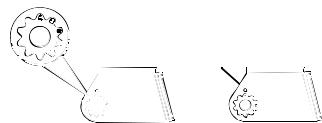
sonars.) Lack of angle adjustment can be particularly troublesome on hulls that sit with the bow high when at rest or at slow trolling speeds.
Third, a transducer CAN NOT shoot through wood and metal hulls. Those hulls require either a transom mount or a thru-hull installation.
Fourth, if your Skimmer transducer has a built in temp sensor, it will only show the temperature of the bilge, not the water surface temp.
Follow the testing procedures listed in the shoot-thru-hull installation section at the end of this lesson to determine if you can satisfactorily shoot through the hull.
Transom Transducer Assembly And Mounting
The best way to install these transducers is to loosely assemble all of the parts first, place the transducer's bracket against the transom and see if you can move the transducer so that it's parallel with the ground.
The following instructions sometimes vary depending on the mounting bracket that came with your transducer. Single-frequency Skimmers come with a one-piece stainless steel bracket, while dual-frequency Skimmers come with a two-piece plastic mounting bracket. Use the set of instructions that fits your model.
1.Assembling the bracket.
A. One-piece bracket: Press the two small plastic ratchets into the sides of the metal bracket as shown in the following illustration. Notice there are letters molded into each ratchet. Place each ratchet into the bracket with the letter "A" aligned with the dot stamped into the metal bracket. This position sets the transducer's coarse angle adjustment for a
14° transom. Most outboard and stern-drive transoms have a 14° angle.
Dot
Align plastic ratchets in bracket.
B. Two-piece bracket: Locate the four plastic ratchets in the transducer's hardware package. Press two ratchets into the sides of the plastic bracket and two on either side of the transducer as shown in the following illustrations. Notice there are letters molded into each ratchet.
Place the ratchets into the bracket with the letter "A" aligned with the
11
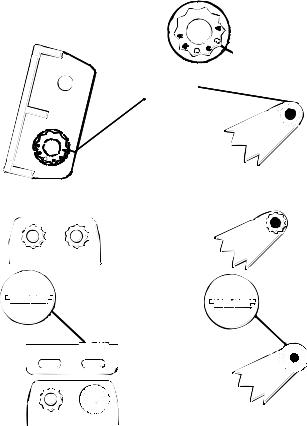
alignment mark molded into the bracket. Place the ratchets onto the transducer with the letter "A" aligned with the 12 o'clock position on the transducer stem. These positions set the transducer's coarse angle adjustment for a 14° transom. Most outboard and stern-drive transoms have a 14° angle.
Alignment letters
Alignment
positions
Transducer |
|
|
Transducer bracket |
|
|
Insert and align ratchets. |
|
|
Transducer |
Transducer |
|
bracket |
||
|
Ratchet |
Ratchet |
|
Add ratchets to bracket and transducer.
2.Aligning the transducer on the transom.
A. One-piece bracket: Slide the transducer between the two ratchets. Temporarily slide the bolt though the transducer assembly and hold it against the transom. Looking at the transducer from the side, check to see if it will adjust so that its face is parallel to the ground. If it does, then the "A" position is correct for your hull.
If the transducer's face isn't parallel with the ground, remove the transducer and ratchets from the bracket.
12
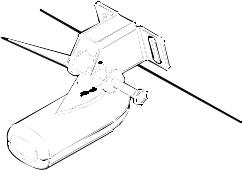
Place the ratchets into the holes in the bracket with the letter "B" aligned with the dot stamped in the bracket.
Reassemble the transducer and bracket and place them against the transom. Again, check to see if you can move the transducer so it's parallel with the ground. If you can, then go to step 3A. If it doesn't, repeat step 2A, but use a different alignment letter until you can place the transducer on the transom correctly.
Ratchets
Insert bolt and check transducer position on transom.
B. Two-piece bracket: Assemble the transducer and bracket as shown in the following figure. Temporarily slide the bolt though the transducer assembly but don't tighten the nut at this time. Hold the assembled transducer and bracket against the transom. Looking at the transducer from the side, check to see if it will adjust so that its face is parallel to the ground. If it does, then the "A" positions are correct for your hull.
If the transducer's face isn't parallel with the ground, remove and disassemble the transducer and ratchets. Place the ratchets into the bracket holes with the letter "B" aligned with the bracket alignment mark. Place them on the transducer aligned with the 12 o'clock position on the transducer stem.
Reassemble the transducer and bracket and place them against the transom. Again, check to see if you can move the transducer so it's parallel with the ground. If you can, then go to step 3B. If it doesn't, repeat step 2B, but use a different alignment letter until you can place the transducer on the transom correctly.
13
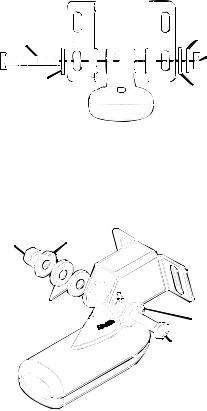
Bolt |
Lock washer |
|
Nut |
||
|
||
Flat washer |
Flat washer |
Assemble transducer and bracket.
3.Assembling the transducer.
A. One-piece bracket: Once you determine the correct position for the ratchets, assemble the transducer as shown in the following fig-
ure. Don't tighten the lock nut at this time.
Metal Nut washer
Rubber |
Metal washer |
washers |
|
|
Bolt |
Assemble transducer and bracket.
B. Two-piece bracket: Once you determine the correct position for the ratchets, assemble the transducer as shown in the figure in step 2B. Don't tighten the lock nut at this time.
4.Drilling mounting holes.
Hold the transducer and bracket assembly against the transom. The transducer should be roughly parallel to the ground. The transducer's centerline should be in line with the bottom of the hull. Don't let the bracket extend below the hull!
Mark the center of each slot for the mounting screw pilot holes. You will drill one hole in the center of each slot.
Drill the holes. For the one-piece bracket, use the #29 bit (for the #10 screws). For the two-piece bracket, use the #20 bit (for the #12 screws).
14
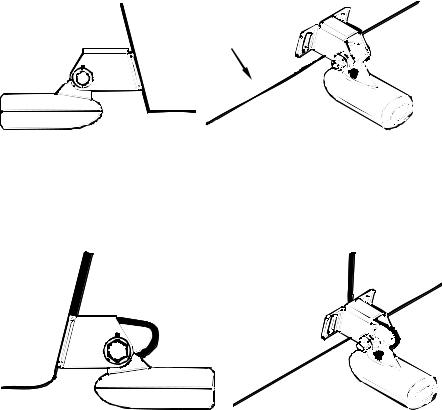
Transom
Transom
Position transducer mount on transom and mark mounting holes. Side view shown, left, and seen from above at right.
5.Attaching transducer to transom.
A. One-piece bracket: Remove the transducer from the bracket and re-assemble it with the cable passing through the bracket over the bolt as shown in the following figures.
For single-frequency Skimmer, route cable over bolt and through bracket. Side view shown, left, and seen from above at right.
Both bracket types: Attach the transducer to the transom. Slide the transducer up or down until it's aligned properly with the bottom of the hull as shown in the preceding and following figures. Tighten the bracket's mounting screws, sealing them with the sealant.
Adjust the transducer so that it's parallel to the ground and tighten the nut until it touches the outer washer, then add 1/4 turn. Don't over tighten the lock nut! If you do, the transducer won't "kick-up" if it strikes an object in the water.
15

Bottom of hull
Flat-bottom hull Deep-"vee" hull
Align transducer centerline with hull bottom and attach transducer to transom. Rear view of dual-frequency Skimmer shown.
6.Route the transducer cable through or over the transom to the sonar unit. Make sure to leave some slack in the cable at the transducer. If possible, route the transducer cable away from other wiring on the boat. Electrical noise from the engine's wiring, bilge pumps, VHF radio wires and cables, and aerators can be picked up by the sonar. Use caution when routing the transducer cable around these wires.
WARNING:
Clamp the transducer cable to the transom close to the transducer. This can prevent the transducer from entering the boat if it is knocked off at high speed.
If you need to drill a hole in the transom to pass the connector through, the required hole size be 1".
Caution:
If you drill a hole in the transom for the cable, make sure it is located above the waterline. After installation, be sure to seal the hole with the same marine grade aboveor below-waterline sealant used for the mounting screws.
7.Make a test run to determine the results. If the bottom is lost at high speed, or if noise appears on the display, try sliding the transducer bracket down. This puts the transducer deeper into the water, hopefully below the turbulence causing the noise. Don't allow the transducer bracket to go below the bottom of the hull!
16
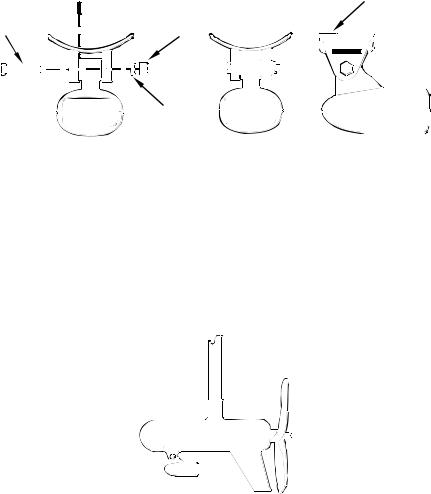
Trolling Motor Bracket Installation (single-frequency only)
1.Attach the optional TMB-S bracket to the transducer as shown in the following figure, using the hardware supplied with the transducer. (Note: The internal tooth washer is supplied with the TMB-S.)
TMB-S bracket

 Internal tooth washer
Internal tooth washer
Bolt |
Nut |
Flat washer
Attach motor mounting bracket to transducer.
2.Slide the adjustable strap supplied with the TMB-S through the slot in the transducer bracket and wrap it around the trolling motor. Position the transducer to aim straight down when the motor is in the water. Tighten the strap securely.
3.Route the transducer cable alongside the trolling motor shaft. Use plastic ties (not included) to attach the transducer cable to the trolling motor shaft. Make sure there is enough slack in the cable for the motor to turn freely. Route the cable to the sonar unit and the transducer is ready for use.
Transducer mounted on trolling motor, side view.
Transducer Orientation and Fish Arches
If you do not get good fish arches on your display, it could be because the transducer is not parallel with the ground when the boat is at rest in the water or at slow trolling speeds.
17
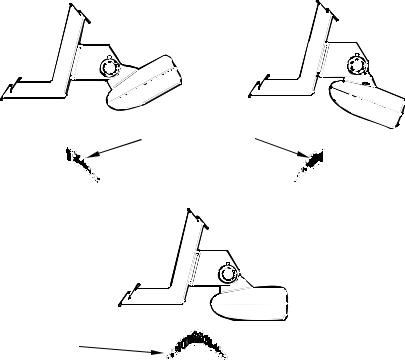
|
Partial fish arches |
Transducer aimed |
Transducer aimed |
too far back |
too far forward |
Full fish arch
Proper transducer angle
Transducer angles and their effects on fish arches.
If the arch slopes up – but not back down – then the front of the transducer is too high and needs to be lowered. If only the back half of the arch is printed, then the nose of the transducer is angled too far down and needs to be raised.
NOTE:
Periodically wash the transducer's face with soap and water to remove any oil film. Oil and dirt on the face will reduce the sensitivity or may even prevent operation.
Shoot-Thru-Hull Preparation
Hulls With Floatation Materials
The transducer installation inside a fiberglass hull must be in an area that does not have air bubbles in the resin or separated fiberglass layers. The sonar signal must pass through solid fiberglass. A successful transducer installation can be made on hulls with flotation materials (such as plywood, balsa wood or foam) between layers of fiberglass if the material is removed from the chosen area. See the following figure.
18
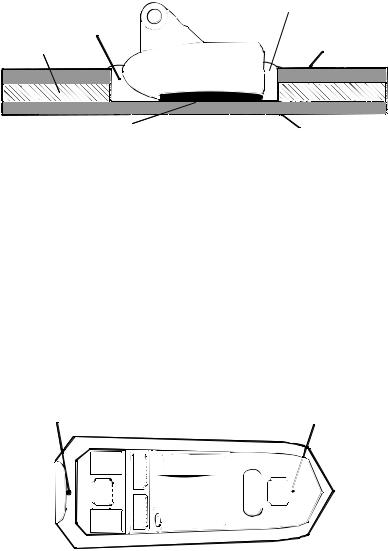
WARNING:
Do not remove any material from your inner hull unless you know the hull's composition. Careless grinding or cutting on your hull can result in damage that could sink your boat. Contact your boat dealer or manufacturer to confirm your hull specifications.
Fill with
Fill with resin
Flotation material |
Inner hull |
Epoxy to hull first |
Outer hull |
Epoxy the transducer to a solid portion of the hull.
For example, some (but not all) manufacturers use a layer of fiberglass, then a core of balsa wood, finishing with an outer layer of fiberglass. Removing the inner layer of fiberglass and the balsa wood core exposes the outer layer of fiberglass. The transducer can then be epoxied directly to the outer layer of fiberglass. After the epoxy cures for 24 hours, fill the remaining space with polyester resin. When the job is finished, the hull is watertight and structurally sound. Remember, the sonar signal must pass through solid fiberglass. Any air bubbles in the fiberglass or the epoxy will reduce or eliminate the sonar signals.
Testing Determines Best Location
Ideally, the shoot-thru transducer should be installed as close to the transom as possible, close to the centerline. This will give you the best performance during high speed maneuvers.
Transducer location |
Transducer location |
(high speed) |
(trolling speed) |
Shoot-thru-hull transducer locations for high speed or trolling speed operation.
19
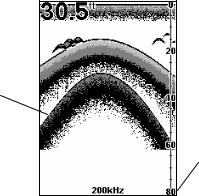
To choose the proper location for shoot-thru-hull mounting, follow these testing procedures: (You may need a helper to complete these steps.)
1.Anchor the boat in about 30 feet of water. Add a little water to the sump of the boat. Plug the transducer into the sonar unit, turn it on, then hold the transducer over the side of the boat in the water. Adjust the sensitivity and range controls until a second bottom echo is seen on the display. (You'll need to turn off Auto Sensitivity, Auto Depth Range and ASP™. Try a range setting that is two to three times the water depth. The harder (more rocky) the bottom, the easier it will be to get a second bottom signal.) Don't touch the controls once they've been set.
 True bottom
True bottom
Second bottom
Manual range setting
Example of a second bottom signal. Unit is in 30 feet of water, with range set at 80 feet and sensitivity set at 87 percent.
2.Next, take the transducer out of the water and place it in the water in the sump of the boat, face down. (The transducer face is shown in the figure on the following page.) Notice how the signal strength decreases. The second bottom signal will probably disappear and the bottom signal intensity will likely decrease.
3.Now move the transducer around to find the best location with the strongest possible bottom signal. If you find a spot with an acceptable bottom signal, mark the location and move on to step 4.
If you can't get an acceptable bottom signal, try turning up the sensitivity by three or five keystrokes and then move the transducer around once more. If you find a spot that works, mark it and move on to step 4.
If you have to turn up sensitivity by more than five keystrokes to get a good signal, the transducer should be mounted on the outside of the hull. This is especially true if you have to turn sensitivity all the way up to get a decent bottom signal.
4. Most people can get good results by following steps 1 through 3, so this step is optional. If you want to make an extra effort to be absolutely
20
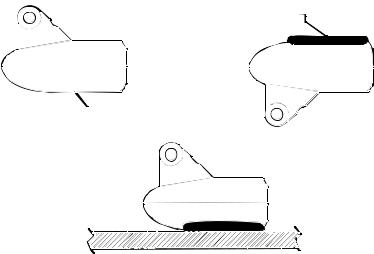
sure that your selected location will work under all conditions, make a test run with the boat on plane and observe the bottom signal. You'll need to figure some way to prop the transducer into position while you make your test run. (A brick or two might be sufficient to hold it in place.)
5. When you're satisfied with a location, mark it and proceed with the installation.
Shoot-thru-hull Installation
If you are installing the transducer on a hull with floatation material sandwiched within the hull, refer to the text "Hulls With Flotation Materials" beginning on page 18.
1.Make sure the area is clean, dry and free of oil or grease, then sand both the inside surface of the hull and the face of the transducer with 100 grit sandpaper. The sanded hull area should be about 1-1/2 times the diameter of the transducer. The surface of the hull must be flat so the entire transducer face is in contact with the hull prior to bonding. After sanding, clean the hull and transducer with rubbing alcohol to remove any sanding debris.
Spread epoxy here
Sand this surface (unit's face)
Orient the Skimmer with the nose facing the bow of the boat.
 To bow
To bow
Epoxy transducer to hull.
WARNING:
Use only the epoxy available from LEI. It has been formulated to work with these installation procedures. Other epoxy types may be too thin or may not cure to the right consistency for optimum transducer performance.
21
2.The epoxy consists of the epoxy itself and a hardener. Remove the two compounds from the package and place them on the paper plate.
Thoroughly stir the two compounds together until the mixture has a uniform color and consistency. Do not mix too fast or bubbles will form in the epoxy. After mixing, you have 20 minutes to complete the installation before the epoxy becomes unworkable.
Spread a thin layer of epoxy (about 1/16" or 1.5 mm thick) on the face of the transducer as shown in the previous figure. Make sure there are no air pockets in the epoxy layer! Then, apply the remaining epoxy to the sanded area on the hull.
3.Press the transducer into the epoxy, twisting and turning it to force any air bubbles out from under the transducer face. Stop pressing when you bottom out on the hull. When you're finished, the face of the transducer should be parallel with the hull, with a minimum amount of epoxy between the hull and transducer.
4.Apply a weight, such as a brick, to hold the transducer in place while the epoxy cures. Be careful not to bump the transducer while the epoxy is wet. Leave the weight in place for a minimum of three hours. Allow the epoxy to cure for 24 hours before moving the boat.
5.After the epoxy has cured, route the cable to the sonar unit and it's ready to use.
Speed/Temperature Sensors
Optional Speed Sensor Installation
All the units in this series can display speed and distance traveled, but only the X-515cDF comes packed with a speed sensor. If you wish to purchase an optional additional sensor for your unit, refer to the accessory ordering information inside the back cover of this manual. The following instructions describe how to install the speed sensor.
Recommended tools for this job include: drill, 7/8" drill bit, 1/8" drill bit for pilot holes, screwdriver. Required supplies for this job include: four #8 stainless steel wood screws (3/4" long), high quality, marine grade aboveor below-waterline sealant.
First find a location on the boat's transom where the water flow is smoothest. Don't mount the sensor behind strakes or ribs. These will disturb the water flow to the speed sensor. Make sure the sensor will remain in the water when the boat is on plane. Also make sure the location doesn't interfere with the boat's trailer. Typically, the sensor is mounted about one foot to the side of the transom's centerline. Once you've determined the proper location for the unit, place the sensor on
22
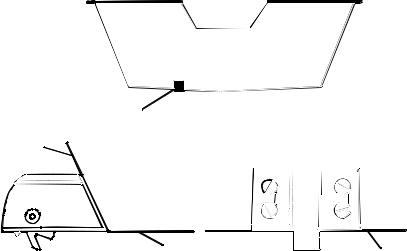
the transom. The bottom of the bracket should be flush with the hull's bottom. Using the sensor as a template, mark the hull for the screws' pilot holes. Drill four 1/8" holes, one in each end of the slots.
Mount the sensor to the hull using #8 stainless steel wood screws (not included). Use a high quality, marine grade aboveor below-waterline sealant to seal the screws. Make sure the sensor is flush with the bottom of the hull and tighten the screws.

 Good
Good location
location
Stern view showing good location for mounting sensor on transom.
Transom
Bottom of hull |
Bottom of hull |
Speed sensor mounting configuration: side view (left) and rear view (right.)
If the base of the transom has a radius, fill the gap between the transom and the sensor with the sealant. This will help ensure a smooth water flow.
Route the sensor's cable through or over the transom to the sonar unit. If you need to drill a hole in the transom to pass the connector through, the required hole size is 7/8".
CAUTION:
If you drill a hole in the transom for the cable, make sure it is located above the waterline. After installation, be sure to seal the hole with the same marine grade aboveor below-waterline sealant used for the screws.
The sensor is now ready for use. Connect the sensor to the sonar socket on the back of your unit and connect the transducer to the speed sensor's socket. If you have any questions concerning the installation of the sensor, please contact your local boat dealer.
23
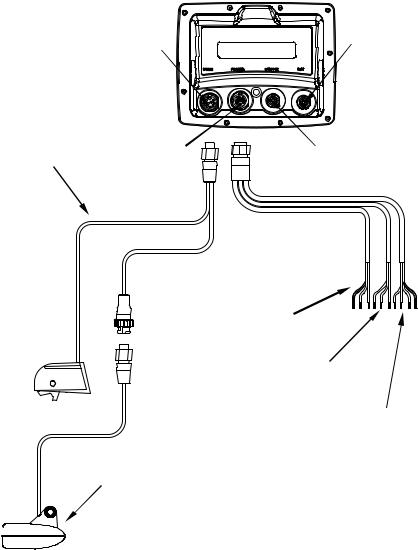
Sonar unit (rear view)
Sonar socket
SP-BL optional
speed sensor Power/Data socket
Transducer
Ethernet (future
enhancement)
Network socket
Display unit power cable
NMEA 2000
Power cable
Data Cable
Sonar unit cable connections.
Power Connections
Your unit comes with a power/data cable that splits into three branches, each with several exposed wires.
The thicker three-wire cable (white, red and black) is the power supply for your display unit. This cable has no label.
24
